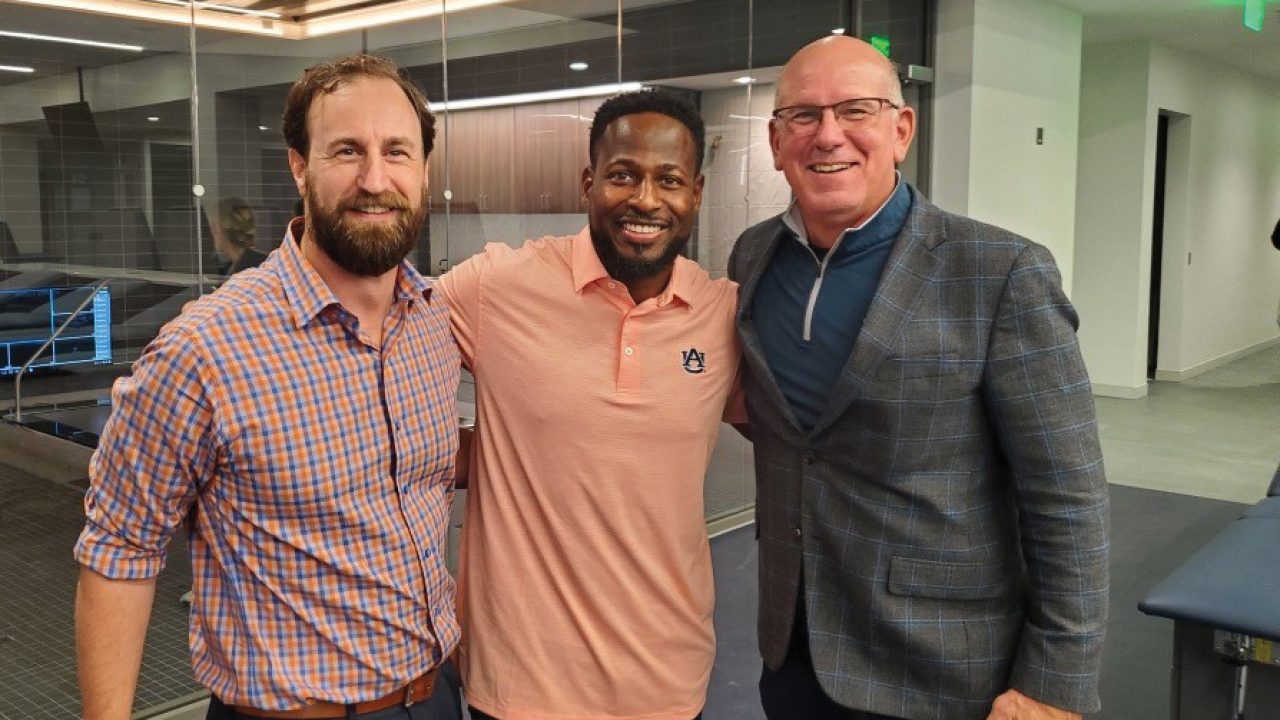Alumni Spotlight: Yann Cowart ’88

Above: Yann Cowart ’88 (right), pictured with Erik Consuegra ’06 (left) and Cadillac Williams (center)
Yann Cowart has made quite the transition in the time he’s spent associated with Auburn Athletics.
Yann Cowart has made quite the transition in the time he’s spent associated with Auburn Athletics. Cowart started his freshman year at Auburn in 1983 as a walk-on football player; this past year he was credited as the lead architect of the new Woltosz Football Performance Center, a massive 12-acre, $92 million facility that is the largest athletics project in Auburn’s history. Cowart, who earned bachelor’s degrees in building science and architecture in 1988, is currently Vice President of Sports Architecture at Goodwyn, Mills and Cawood, Inc. He is also a member of the Industry Executive Board, a group of professionals who offer advice on industry trends to the faculty of the McWhorter School of Building Science.
Cowart has spent much of his career designing sports facilities for collegiate and high school facilities throughout the Southeast. Some of his recent projects include Protective Stadium and the UAB Football Performance Center/Legacy Pavilion in Birmingham, Alabama, as well as new football facilities at Clemson University and the University of Alabama-Birmingham and the basketball arena at Jacksonville State. The sports design team at Goodwyn, Mills and Cawood also recently completed the redesign of the Women’s Basketball locker room at Auburn which, along with the Woltosz Football Performance Center, was featured in Athletic Business Magazine’s 26th Annual Architectural Showcase.
Cowart’s first project on Auburn’s campus was the McWhorter Center for Women’s Athletics in the late 1990s. “It was the first real job that I had gone out and marketed, secured the client and won the job,” he recalled. “It’s still a beautiful building.” He has also completed the football team’s Harbert Recruiting Center, the Yarborough Tennis Center and locker room renovations for the baseball, soccer and track teams. He’s worked on several academic buildings as well including the Kinesiology Building, the College of Forestry, Wildlife and Environment building and the Harrison College of Pharmacy laboratory. ”
While the Woltosz Football Performance Center is not Cowart’s first project on Auburn’s campus, it’s certainly the largest. The facility includes two full-sized natural grass outdoor fields, an indoor practice facility and a 25,000 square foot strength and conditioning space. Cowart says that when designing for athletic teams, it’s important to understand both the physical needs of the athletes and staff as well as the core principles that create a team’s culture and identity. However, in today’s rapidly changing athletic landscape, Cowart considers industry trends and spends a lot of time interviewing stakeholders to determine how the needs of the team may change. “We want to make sure the building has as much potential to do whatever they need to do in the future, so it’s got to be flexible, adaptable and durable,” he explained. “Athletes can be pretty rough on the finishes of a building. And the sports world is going to be completely different five years from now so we try to think about that.”
He also knows that the most important part of building athletic facilities is delivering a product that has immense value to the team, whether it helps a coach to recruit or an athlete to perform at a higher level. When he started working on the Woltosz Football Performance Center, he reminded the design team that this project was not about improving their portfolios but about creating a building that would benefit the customer. “These buildings are about recruiting. This is about presenting a building that prepares those athletes to be as good as they can be and makes them feel at home,” he stated.
Between his academic experience, the lessons learned on the football field and the incredible design work he’s done on campus, Cowart says he owes a lot to Auburn University. “I’ve been lucky to be associated with it since I was 17. Everything I have has got some tie to this university and the people here. Auburn is home.
See more in:
Alumni